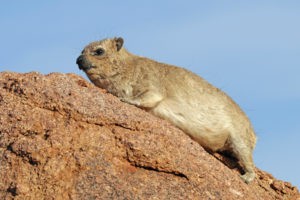Hyrax sounds like a pokemon to me. But in fact, it is a mammal! Hyraxes are native to Africa and Arabia.

That is not easy nor the west entirely, isn’t it? A hyrax has an extended nuclear family, of a rock hyrax, bush hyrax, and a tree hyrax!
Hyraxes have several aliases, they are dassie, conies and rock rabbits. Scientists prefer not using these names, because they are misleading. A hyrax can live up to 14 years.
Hyrax Pet:
Adopting a hyrax as a pet is not a great idea. These animals have very sharp teeth. They are capable of attacking and injuring people. Though they are small, hyraxes are nervous animals. A hyrax eats only once in a day and spends the rest of the day hibernating. Hyraxes have a tough time maintaining their body temperatures. This leads them to hide in caves and between rocks.
Housing hyraxes together could cause ego issues as well. Two of three hyrax species are friendly. Their habitat includes lots of rocks. Unless you stay up in the mountains, you might want to consider a different pet. The type of hyrax adopted also plays a role. Here are the different types:
Read more on exotic pets here!
Tree Hyrax:
The scientific name of a tree hyrax is dendrohyrax arboreus. The other different names are Eastern Tree Hyrax or Dassie and southern tree dassie. This herbivorous animal has brownish-grey fur, with a beige patch on their backs. This marks the location of the dorsal gland. They have dens in hollow tree branches and barks. Tree hyraxes are nocturnal.
Tree hyraxes rarely get off the tree. They are not very down to earth that way. The tree hyrax makes a shrieking noise to announce his territory. The average lifespan of a southern tree dassie is 10 years. The feet if tree hyraxes are not helpful in rock climbing. A tree hyrax is a solitary animal. They are rarely spotted in groups.
Rock Hyrax:
The rock hyraxes or Procavia capensis are small animals native to Africa. A hyrax is often mistaken for an oversized rodent. A rock hyrax, but, has short ears, and short sturdy legs. Their coat ranges from brown to grey. They have a black patch on their back. When the rock hyrax is angry or frightened, the hair on this patch stands up.

Rock hyraxes are also called cape hyraxes. A cape hyrax can live for a maximum of 12 years. They weigh between 2 to 5 kilograms. Rock hyraxes are spread across Africa and the Arabian terrain.
Yellow-spotted Hyrax:
All of us have pet names. Yellow-spotted hyraxes have quite a few! But you know how each close friend calls you a different name? The people across Africa have many names for hyraxes too. Let’s see if you have as many as this hyrax species do!
Bush hyrax, hoggar hyrax, Geelkoldassie, Imbila, and Tshwanye are their indigenious names.
Bush hyraxes are well distributed across East Africa and South Africa. Yellow-spotted hyraxes rest on cliffs and rocks like the rock hyraxes. They tend to co-exist. One can spot the two species sunbathing together. Yellow-spotted hyraxes do not prefer isolated rock spaces like their relatives.
Leaves, stems, and barks are part of their main diet. Births occur as the rainfall is at its peak. Bush hyraxes forage for food. Yellow-spotted hyraxes are not endangered yet. Bush hyraxes are lively animals. They actively seek out shelter as and when the weather demands. They hide in caves when the summer heat gets too unbearable.
Bush hyraxes have a whisker-like hair called vibrissae. It is above their eyes, on the chin, on their back and sides of the body. Vibrissae are present even on their legs. This acts as their 6th sense. It helps a hyrax feel what it around it, even in the dark! Yellow-spotted hyraxes weigh between 1 to 3 kilograms.
Hyrax Animal facts:
- Hyraxes are related to elephants. I am not joking!! Hyraxes have incisor teeth that grow out to be tiny tusks like elephants.
- The bible mentions a hyrax. Cony in the bible refers to the hyrax.
- Did you know, hyraxes have a rubbery texture beneath their feet? This acts like their ingrown sole. In the middle of the sole, there is a hollow gap. This acts as a plunger of sorts. It helps hyrax climb trees and steep rocks.
- Hyraxes are well trained- to urinate in the same spot. Yes, they pick one spot and stick to it for a lifetime. Hyraxes urine has a lot of calcium carbonate, which tends to turn cliffs white after a point.

- The calcium carbonate crystals were common to treat epilepsy, hysteria and other diseases.
- Human beings can regulate their body temperatures to suit the environment. This is behavioral thermoregulation! Hyraxes exhibit behavioral thermoregulation too!
- Hyraxes are nervous eaters. They eat in groups and often lookout for predators. A male hyrax shrieks, this is an alarm call for the rest of the group to scatter.
- Hyraxes live in colonies known as “kopjes”. They can range anywhere between 5 to 60 hyraxes. Each of these groups has one male hyrax that leads the group. More than one species can coexist. The bush and rock hyraxes are usually spotted together.
- A baby hyrax is called a pup. They are born with their eyes open.
- Do you drink 7 liters of water a day? If you do, good going. But if you do not, don’t fret! Hyraxes do not consume too much water. Their kidneys help retain the moisture from the food they digest.
- Rock hyraxes have excellent vision. This helps them spot their prey from almost a kilometer away! I wish I had such a good 50/50 vision, don’t you?
- A hyrax’s stomach has 3 chambers, with symbiotic bacteria that help break down the food they consume. Pups do not have this bacteria in their stomachs. They eat their parents’ fecal matter to consume the bacteria.”
- We have fancy razors, body butter and what not to groom ourselves. Hyraxes have a specific long nail- a grooming claw.

- Hyraxes eat in a group. They sit in a circle with their heads always facing outward in search of their incoming predator.
- Common predators of a hyrax are eagles, anacondas, leopards and jaguars.
So this was it about The Hyrax. Do you have any doubts, comment below!
